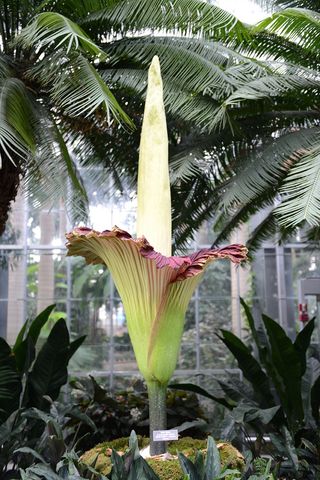
Foul Corpse Flower Blooms in Washington

The aptly nicknamed corpse flower on display in Washington, D.C., has finally gone into full bloom, unleashing a stench like rotting flesh inside the U.S. Botanic Garden Conservatory.
The visual and olfactory spectacle is a rare and brief event. The foul-smelling flower, also called the titan arum, will only be open for 24 to 48 hours before it collapses. This is the first time a blossoming specimen has been on display at the U.S. Botanic Garden since 2007.
The tall titan arum has been on view for more than a week in preparation for the malodorous bloom. Crowds poured in to the conservatory, next to the U.S. Capitol Building, when it opened this morning (July 22), after news that the titan arum started blooming around 4:00 p.m. ET on Sunday (July 21). A livestream from the U.S. Botanic Garden showed hordes of people standing in front of the tall plant taking pictures.
Scientifically named Amorphophallus titanium, the plant is native to the rain forests of central Sumatra in western Indonesia and was first discovered by researchers in 1878. [In Images: A Corpse Flower Blooms]
What looks like a giant petal opening up is actually a feature called a spathe, and the plant's tube-like spike at its center is called a spadix. The blossom is made up of thousands of little flowers in a cluster on the spadix called an inflorescence. In the titan arum, this structure can stretch up to 10 feet (3 meters) high, which helps its stink travel over a wide area.
The plant mimics the smell of death as part of a clever evolutionary strategy. Flesh-eating pollinators like flies and carrion beetles are attracted to the flower's rotten odor and the warmth it generates. The insects get coated with pollen when they crawl into the plant's spadix and then fly away to cross-pollinate another titan arum in bloom.
The titan arum isn't alone in its sneaky ability to stink. A new study found that this strategy evolved independently at least five different times in unrelated plant families, such as the dead horse arum, a plant native to the Mediterranean islands of Corsica and Sardinia.
Sign up for the Live Science daily newsletter now
Get the world’s most fascinating discoveries delivered straight to your inbox.
Follow Megan Gannon on Twitter and Google+. Follow OurAmazingPlanet @OAPlanet, Facebook and Google+. Original article on LiveScience's OurAmazingPlanet.
